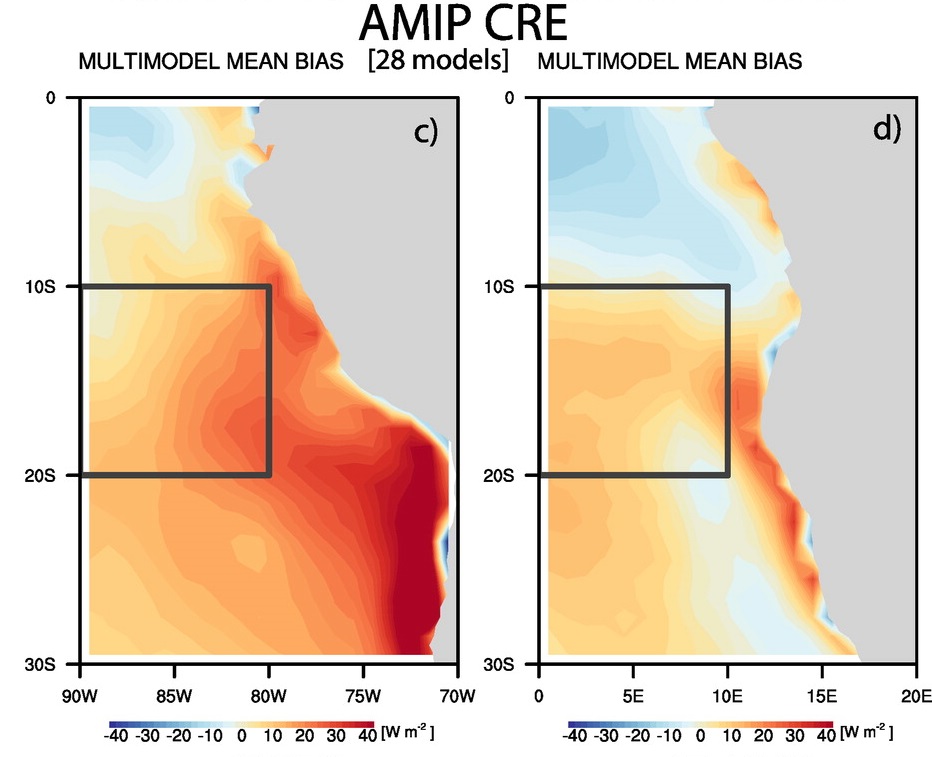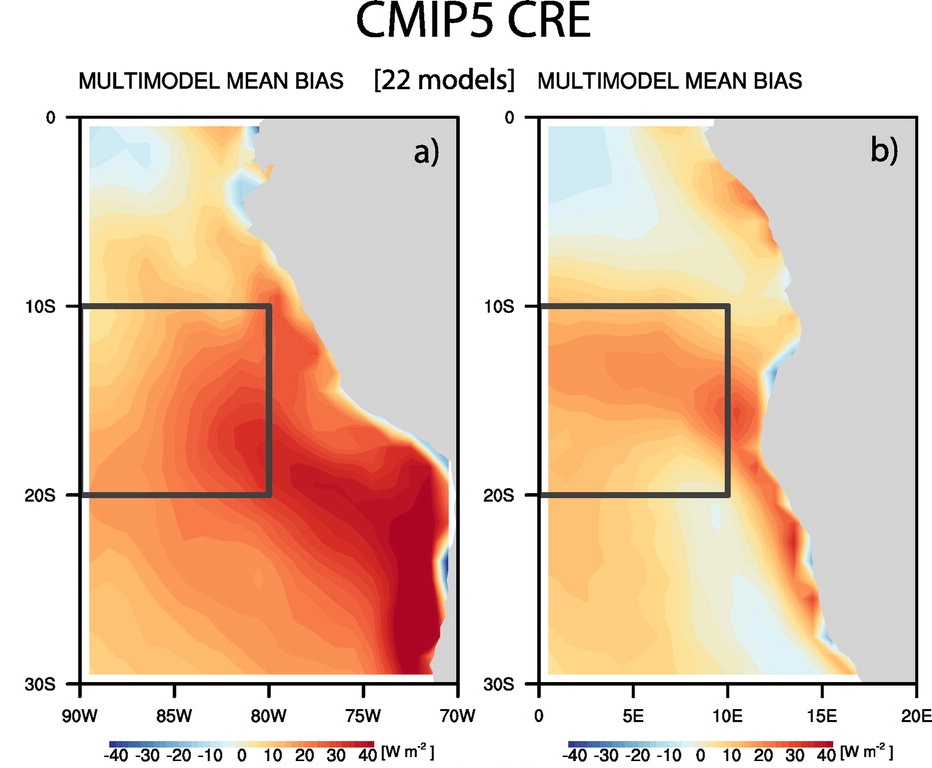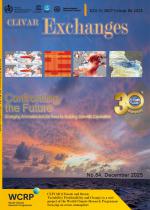Can the SST biases in coupled climate model simulations of the eastern tropical Atlantic and Pacific oceans be reduced?

Sea surface temperatures that are too warm in the eastern tropical Atlantic and Pacific oceans have long stymied coupled climate model depictions of our planet. A fresh look and update was undertaken by the international Eastern Tropical Oceans Synthesis Working Group, with a specific focus on comparing and contrasting the physical processes governing the two basins. Too few low clouds in models with free-running SSTs have long been associated with the SST errors, but a startling finding is that the cloud impact on the surface radiation budget is also unrealistically low in fixed-SST simulations (Figure 1, see also Medeiros 2012). While this squarely places the error in the atmospheric model components, a bright note is that most models capture the seasonal cycle in the lower tropospheric stability, the dominant control on the low cloud fraction, correctly. The causes for the SST errors are many, with the relative contributions differing between models, and no quick-fix solution presents itself. Nevertheless, room for optimism can be found in the increasing understanding of the oceanic and atmospheric contributions to the largest of the SST errors occurring in the oceanic upwelling region offshore of Namibia (Small et al., 2015; Patricola et al. 2016), in the improvement possible with higher-resolution oceans and atmospheres (e.g., Kirtman et al., 2012), and increasingly sophisticated approaches to identifying the sources of individual SST errors (e.g., Toniazzo and Woolnough, 2014; Ma et al., 2015). Recent and ongoing fieldwork, both oceanic (preface.b.uib.no) and atmospheric (Zuidema et al., 2016b) are providing new datasets with which to guide process models, develop new parameterizations and otherwise encourage model understanding and improvement. For more detail, please visit doi:10.1175/BAMS-D-15-00274.1 within the December issue of BAMS.


Fig. 1. (left) Composite annual-mean net CRE biases with respect to CERES values reveal larger cloud radiative biases in (a) the Pacific than in (b) the Atlantic, based on 22 CMIP5 models. The largest biases occur at the coast. (right) Fixed-SST (AMIP) simulations reveal similar annual-mean cloud biases in (c) the Pacific and (d) the Atlantic, implicating the atmosphere as the source for low-cloud errors, based on 28 models spanning 1950–99 when available, with most simulations beginning in 1979. The AMIP ensemble is composed of different models than the CMIP5 ensemble, based on data availability. Reproduced from Fig. 8 of Zuidema et al., (2016a), original figure by Brian Medeiros. ©American Meteorological Society. Used with permission.
Reference:
Kirtman, and Coauthors, 2012: Impact of ocean model resolution on CCSM climate simulations. Climate Dyn., 39, 1303–1328, doi:10.1007/s00382-012-1500-3.
Ma, H.-Y. and Coauthors, 2015: An improved hindcast approach for evaluation and diagnosis of physical processes in global climate models. J. Adv. Model. Earth Syst., 7, 1810–1827, doi: 10.1002/2015MS000490.
Medeiros, B., D. L. Williamson, C. Hannay, and J. G. Olsen, 2012: Southeast Pacific stratocumulus in the Community Atmosphere Model. J. Climate, 25, 6175–6192, doi:10.1175/JCLI-D-11-00503.1
Patricola, C. M. and P. Chang, 2016: Structure and dynamics of the Benguela low-level coastal jet, Climate Dynamics, 47,doi:10.1007/s00382-016-3479-7
Small, R. J., E. Curchitser, K. Hedstrom, B. Kauffman, and W. Large, 2015: The Benguela upwelling system: Quantifying the sensitivity to resolution and coastal wind representation in a global climate model. J. Climate, 28, 9409–9432, doi:10.1175/JCLI-D-15-0192.1.
Toniazzo, T., and S. Woolnough, 2014: Development of warm SST errors in the southern tropical Atlantic decadal hindcasts. Climate Dyn., 43, 2889–2913, doi:10.1007/s00382-013-1691-2
Zuidema, P., P. Chang, B. Medeiros, B. Kirtman, R. Mechoso, E. Schneider, T. Toniazzo, I. Richter, J. Small, K. Bellomo, P. Brandt, S. de Szoeke, T. Farrar, E. Jung, S. Kato, M. Li, C. Patricola, Z. Wang, R. Wood, and Z. Xu, 2016a: Challenges and prospects for reducing coupled climate model SST biases in the eastern tropical Atlantic and Pacific oceans: The US CLIVAR Eastern Tropical Oceans Synthesis Working Group. Bull. Am. Meteorol. Soc., 97, 2305-2327, doi:10.1175/BAMS-D-15-00274.1
Zuidema, P. , J. Redemann, J. Haywood, R. Wood, S. Piketh, M. Hipondoka, and P. Formenti, 2016b: Smoke and clouds above the southeast Atlantic: Upcoming field campaigns probe absorbing aerosol’s impact on climate. Bull. Amer. Meteor. Soc., 97, 1131–1135, doi:10.1175/BAMS-D-15-00082.1.
Summary written by Paquita Zuidema
************************************************************************************************************
Challenges and Prospects for Reducing Coupled Climate Model SST Biases in the Eastern Tropical Atlantic and Pacific Oceans: The U.S. CLIVAR Eastern Tropical Oceans Synthesis Working Group (Bulletin of the American Meteorological Society)
Paquita Zuidema, Ping Chang,Brian Medeiros, Ben Kirtman, Roberto Mechoso, Edwin K. Schneider, Thomas Toniazzo, Ingo Richter, R. Justin Small, Katinka Bellomo, Peter Brandt, Simon de Szoeke, J.Thomas Farrar, Eunsil Jung, Seiji Kato, Mingkui Li, Christina Patricola, Zaiyu Wang, Robert Wood, and Zhao Xu











Add new comment